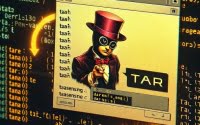‘screen’ User Guide | Using Multiple Terminals in Linux

Ever felt overwhelmed when trying to manage multiple terminal sessions simultaneously in Linux? You’re not alone. Many developers find themselves in a similar situation, but there’s a tool that can make this process effortless. Like a skilled juggler, the ‘screen’ command in Linux allows you to handle multiple terminal sessions with ease.
This guide will walk you through the ins and outs of the ‘screen’ command, from basic usage to advanced techniques. We’ll explore screen’s core functionality, delve into its advanced features, and even discuss common issues and their solutions.
So, let’s dive in and start mastering the screen command in Linux!
TL;DR: What is the ‘screen’ command in Linux and how do I use it?
The
'screen'command in Linux is a full-screen window manager that multiplexes a physical terminal between several processes. You can create a screen session with the syntax,screen -S new_session, and you can disconnect with the keytroke,Ctrl-a d. You can then connect to any detached session with the syntax,screen -r session_name.
Here’s a basic example of how to use it:
screen -S my_session
In this example, the ‘screen’ command starts a new screen session named ‘my_session’. This session runs independently and continues even if you get disconnected.
This is just a glimpse of what the ‘screen’ command can do. There’s much more to learn about managing terminal sessions with ‘screen’. Continue reading for more detailed information and advanced usage scenarios.
Table of Contents
- Basic Use of Screen Command
- Advanced Usage: Screen Command Options
- Exploring Alternatives: Terminal Multiplexing with Tmux
- Troubleshooting Screen Command Issues
- Best Practices and Optimization Tips
- Understanding Terminal Multiplexing
- The Evolution of the Screen Command
- Real-World Applications of the Screen Command
- Wrapping Up: Mastering the Screen Command in Linux
Basic Use of Screen Command
The ‘screen’ command in Linux is a powerful tool, but its basic usage is quite straightforward. Let’s start by creating a new screen session.
screen -S beginner_session
# Output:
# [No output. A new screen session starts.]
This command starts a new screen session named ‘beginner_session’. You can replace ‘beginner_session’ with any name of your choice.
Now, suppose you are running a program in this session and you want to do something else without stopping the program. You can ‘detach’ from the screen session using the following command:
# Detach from screen session
Ctrl-a d
# Output:
# [No output. You'll be returned to your normal shell.]
The program you were running in the screen session continues to run in the background. You can then ‘resume’ your screen session at any time using the following command:
screen -r beginner_session
# Output:
# [No output. You'll be returned to your screen session.]
This will bring you back to your ‘beginner_session’, right where you left off.
The ‘screen’ command’s ability to manage multiple terminal sessions simultaneously is a significant advantage. It allows you to multitask efficiently, switching between different programs and processes without having to stop and start them.
However, like any powerful tool, it comes with potential pitfalls. For instance, if you start a screen session and forget to detach, you may accidentally close the terminal and lose your work. Therefore, it’s essential to always remember to detach from a screen session before closing your terminal.
Advanced Usage: Screen Command Options
As you become more comfortable with the basic use of the ‘screen’ command, you can start to explore its more advanced features. These include splitting windows, session sharing, and session logging. But before we dive into these advanced uses, let’s familiarize ourselves with some command-line arguments or flags that can modify the behavior of the ‘screen’ command.
Here’s a table with some of the most commonly used ‘screen’ command arguments:
| Argument | Description | Example |
|---|---|---|
-ls | Lists all the current screen sessions. | screen -ls |
-r | Resumes a detached screen session. | screen -r sessionname |
-d | Detaches an existing screen session. | screen -d sessionname |
-S | Starts a new screen session with a specific name. | screen -S sessionname |
-X | Sends a command to a running screen session. | screen -X -S sessionname quit |
-D -RR | Attaches to a screen session. If the session is attached elsewhere, detaches that other display. | screen -D -RR sessionname |
-dmS | Starts a new detached screen session with a specific name. | screen -dmS sessionname |
-p | Preselects a window. | screen -p 0 -S sessionname |
-h | Sets the scrollback buffer lines. | screen -h 1000 |
Now that we have a basic understanding of the ‘screen’ command line arguments, let’s dive deeper into the advanced use of ‘screen’.
Splitting Windows
One of the powerful features of ‘screen’ is its ability to split terminal windows. You can split your terminal into multiple regions and have different sessions in each region. Here’s how to do it:
# First, start a new screen session
screen -S split_example
# Next, split the window vertically
Ctrl-a |
# Now, you can switch between regions using
Ctrl-a TAB
# To start a new session in the active region
Ctrl-a c
# Output:
# [No output. Your terminal window will be split into two regions, with a new session in the active region.]
Session Sharing
Another advanced use of ‘screen’ is session sharing. This feature allows multiple users to view and control a screen session simultaneously. Here’s an example:
# Start a new screen session
screen -S shared_example
# Detach from the session
Ctrl-a d
# Now, another user can attach to your session with
screen -x shared_example
# Output:
# [No output. The other user will see the same terminal window as you.]
Session Logging
The ‘screen’ command also allows you to log all your terminal activities. This is particularly useful when you need to keep track of what you did in a session. Here’s how to enable logging:
# Start a new screen session with logging enabled
screen -L -S log_example
# Output:
# [No output. A log file named 'screenlog.0' will be created in your current directory.]
These are just a few examples of the advanced uses of the ‘screen’ command. By mastering these features, you can significantly enhance your productivity and efficiency when working with the terminal in Linux.
Exploring Alternatives: Terminal Multiplexing with Tmux
While the ‘screen’ command is a powerful tool for terminal multiplexing in Linux, it’s not the only game in town. Another popular alternative is ‘tmux’, which stands for Terminal Multiplexer.
What is Tmux?
Tmux is a modern, feature-rich terminal multiplexer, much like ‘screen’. It allows you to manage multiple terminal sessions within one console or terminal emulator window. Tmux is highly configurable and comes with a set of commands and a syntax that is consistent and easy to learn.
Here’s a simple example of starting a new ‘tmux’ session:
tmux new -s my_tmux_session
# Output:
# [No output. A new tmux session starts.]
Tmux vs Screen: A Comparison
While both ‘screen’ and ‘tmux’ offer similar functionality, there are some key differences that might make you prefer one over the other.
| Feature | Screen | Tmux |
|---|---|---|
| Status Bar | Basic | Highly configurable |
| Window Splitting | Vertical only | Vertical and horizontal |
| Session Management | Less intuitive | More intuitive |
| Configuration | Less flexible | More flexible |
| Command Naming | Less consistent | More consistent |
Making the Choice Between Screen and Tmux
Ultimately, the choice between ‘screen’ and ‘tmux’ depends on your specific needs. If you’re looking for a simple and straightforward tool for managing multiple terminal sessions, ‘screen’ might be all you need. However, if you want more advanced features and don’t mind a steeper learning curve, ‘tmux’ might be the better choice.
Remember, the best tool is the one that helps you work most efficiently. So, feel free to experiment with both ‘screen’ and ‘tmux’ to see which one fits your workflow best.
Troubleshooting Screen Command Issues
Like any tool, the ‘screen’ command in Linux can sometimes present challenges. Let’s discuss some common issues encountered when using the ‘screen’ command and how to resolve them.
Issue 1: Recovering Detached Sessions
One common issue is forgetting the name of a detached screen session. If you can’t remember the name, you can’t reattach to it. Here’s how to list all your screen sessions:
screen -ls
# Output:
# There are screens on:
# 12345.my_session (Detached)
# 67890.another_session (Detached)
# 2 Sockets in /var/run/screen/S-username.
The screen -ls command lists all your screen sessions, making it easy to find the one you want to reattach to.
Issue 2: Exiting Screen Sessions
Another common issue is not knowing how to exit or ‘kill’ a screen session. Here’s how to do it:
# First, reattach to the session
screen -r my_session
# Then, terminate the session
Ctrl-a k
# Output:
# [screen is terminating]
The Ctrl-a k command will kill the current screen session.
Best Practices and Optimization Tips
Here are some best practices and tips for optimizing your use of the ‘screen’ command:
- Always name your sessions: This makes it easier to manage and reattach to them later.
- Detach before you exit: Always remember to detach from a screen session before you close your terminal. This will ensure that your screen sessions continue running.
- Use the scrollback buffer: The ‘screen’ command allows you to scroll back and view output that has scrolled off the screen. Use
Ctrl-a [to enter scrollback mode, andCtrl-a ]to exit. - Customize your .screenrc file: The .screenrc file allows you to customize the behavior of ‘screen’. You can set up key bindings, change the status line, and more.
Mastering these troubleshooting techniques and best practices will help you make the most of the ‘screen’ command in Linux.
Understanding Terminal Multiplexing
Terminal multiplexing is a powerful concept in the world of Linux. But what exactly is it, and why is it useful?
Terminal multiplexing is the ability to create, manage, and control multiple terminal sessions from a single terminal window. This is incredibly useful when you’re working with remote servers, running long-lasting processes, or managing multiple tasks simultaneously.
Let’s consider a simple scenario. You’re connected to a remote server via SSH and running a process that takes a long time to complete. Suddenly, your internet connection drops, and your SSH session is disconnected. Unfortunately, this means your long-running process is also terminated.
This is where terminal multiplexing comes in. With a tool like ‘screen’, your processes continue to run, even if your SSH session is disconnected. You can then reattach to your screen session and pick up right where you left off.
The Evolution of the Screen Command
The ‘screen’ command was first released in 1987 by Oliver Laumann. It was designed as a full-screen window manager that multiplexes a physical terminal between several processes. Over the years, ‘screen’ has been improved and updated by various contributors, but its core functionality remains the same.
The ‘screen’ command works by creating a shell within your terminal that can host multiple other shells. Each of these shells (or ‘windows’) operates independently, and you can switch between them as needed.
Here’s a simple example of creating two windows within a screen session:
# Start a new screen session
screen -S example_session
# Create a new window
Ctrl-a c
# Switch between windows
Ctrl-a n
# Output:
# [No output. You'll be switched to the next window in your screen session.]
In this example, the ‘screen -S example_session’ command starts a new screen session named ‘example_session’. The ‘Ctrl-a c’ command creates a new window within the screen session. The ‘Ctrl-a n’ command then switches to the next window in the session.
This ability to manage multiple terminal sessions from a single terminal window is what makes the ‘screen’ command such a powerful tool in Linux.
Real-World Applications of the Screen Command
The ‘screen’ command is not just a theoretical concept; it has practical applications in real-world scenarios. Let’s look at a couple of use cases where the ‘screen’ command shines.
Remote Server Management
When managing remote servers, you often need to run processes that take a long time to complete. The ‘screen’ command allows you to start a process in a screen session, detach from it, and then reattach later. This way, the process continues to run, even if your SSH session is disconnected.
# Start a long-running process in a screen session
screen -S long_process
./run_long_process.sh
# Detach from the screen session
Ctrl-a d
# Output:
# [No output. The long-running process continues in the background.]
Handling Long-Running Tasks
If you’re running a task that takes a long time to complete, you can start it in a screen session and then detach. This allows you to use your terminal for other tasks while the long-running task continues in the background.
# Start a long-running task in a screen session
screen -S long_task
./run_long_task.sh
# Detach from the screen session
Ctrl-a d
# Output:
# [No output. The long-running task continues in the background.]
Related Commands
The ‘screen’ command often works in tandem with other commands. For instance, you might use ‘top’ to monitor system performance within a screen session, or ‘vim’ to edit files. Here’s an example of using ‘top’ within a screen session:
# Start a new screen session
screen -S top_session
# Run top
top
# Output:
# [No output. The top command starts in your screen session.]
Further Resources for Mastering the Screen Command
For those interested in delving deeper into the ‘screen’ command, here are some additional resources:
- GNU Screen Manual – The official manual for ‘screen’ from GNU.
Using GNU Screen to Manage Persistent Terminal Sessions – A tutorial from DigitalOcean.
Screen User’s Manual – A comprehensive user’s manual for ‘screen’ from Linux.org.
Wrapping Up: Mastering the Screen Command in Linux
This comprehensive guide has taken you on a journey through the ins and outs of the ‘screen’ command in Linux. From managing multiple terminal sessions to advanced techniques like window splitting and session sharing, we’ve explored the vast capabilities of this powerful utility.
We began with the basics, understanding how to start, detach, and resume screen sessions. We then delved into more complex uses of the ‘screen’ command, such as splitting windows, session sharing, and session logging. Along the way, we addressed common issues encountered when using the ‘screen’ command and their solutions, providing you with a solid foundation for troubleshooting and optimization.
We also ventured beyond the ‘screen’ command, introducing an alternative approach for terminal multiplexing, namely ‘tmux’. We discussed the pros and cons of these alternatives, giving you a broader perspective on terminal multiplexing tools.
| Tool | Usability | Features | Flexibility |
|---|---|---|---|
| Screen | Easy to use, intuitive | Multiple terminal sessions, window splitting, session sharing, session logging | Highly configurable with .screenrc file |
| Tmux | Steeper learning curve | Similar to ‘screen’, plus vertical and horizontal splitting, more intuitive session management | More flexible configuration |
Whether you’re just starting out with the ‘screen’ command or looking to enhance your skills, we hope this guide has been a valuable resource. The ability to manage multiple terminal sessions effectively is a powerful skill in the Linux world, and mastering the ‘screen’ command is a significant step in that direction. Happy coding!


